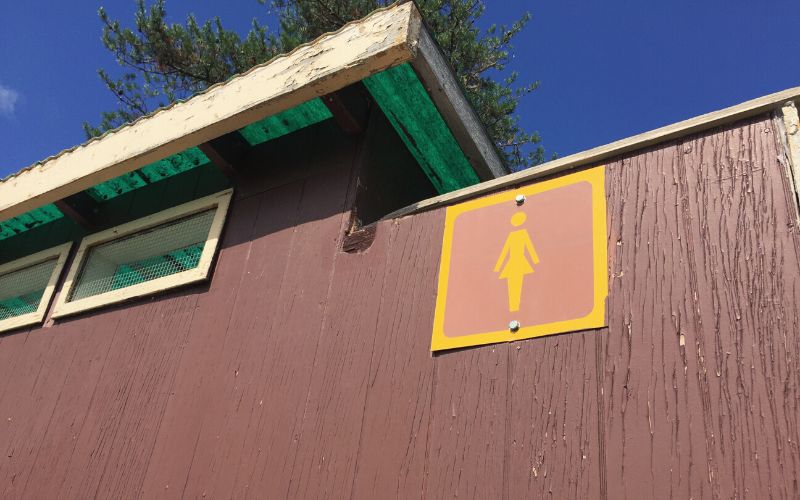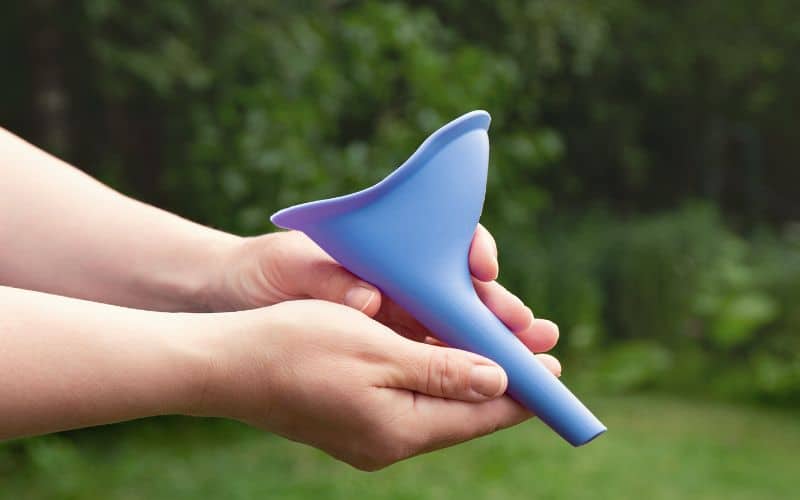Whether hiking up a mountain or camping in the backcountry, there comes a time in every outdoorsy woman’s life when she has to learn to pee in nature.
Everybody pees, but not everybody knows how to do it in the wilderness. Like most things in life, mastering the art of urinating outside takes some practice and know-how. And, if you have the fear of being seen in the process of relieving yourself, you are not the only one!
This tutorial goes over everything you need to know to take care of business when nature calls, including three different techniques and step-by-step instructions.
Table of Contents
What You’ll Need to Follow This Tutorial
To get started peeing outside, you’ll need the following:
- A tree, rock, or (preferably close) friend (Method 1)
- A FUD (Method 2)
- Desperation and shorts (Method 3)
- Toilet paper or pee rag
- Baby wipes
- Hand sanitizer
- No toilet within a reasonable walking distance

How to Pee Outside: 3 Methods and Step-by-Step Instructions
Method 1: The Squat
A deep squat is the classic technique used by most women when whizzing in the wilderness.
Step 1: Find a Hidden Spot
Search for a nearby secluded spot behind a tree, boulder, or bush. Have someone be your lookout/spotter if you can’t find anything to hide behind.
Step 2: Squat Down
Pull your pants down, spread your feet at least hip-width apart, and squat deeply to get things underway. Lean back on your ankles for more support and get as close to the ground as possible.
It’s hard to achieve a deep enough squat with tired legs or wobbly knees. If that’s the case, try an assisted squat. Use a fallen tree, stump, large rock, or even a trusted friend to lean your back against or hold onto when squatting to take some weight off your legs and knees.

Method 2: The FUD
A female urination device (FUD) gives women the freedom to successfully pee while standing and fully clothed. Many women have become devotees of the FUD in recent years thanks to its practicality and convenience.
Step 1: Choose Your FUD
There are many different styles and sizes of female urination devices, commonly called “pee funnels”, used by outdoor enthusiasts. They typically feature a funnel end that is placed inside the pants to collect the urine without having to completely remove your pants. The other end has a spout through which your urine flows and is liberated into the wild.
The SheeWee is a popular reusable and lightweight FUD with a variety of designs and a discreet travel case.
Step 2: Find a Spot
Finding an appropriate place to urinate is much easier with a funnel since you don’t have to completely expose your bare ass. Take a few steps away from the hiking path or tent and position your back towards any people or find cover behind a tree.
Step 3: Position the Funnel
Take the funnel out of its carry case, then unzip your pants while standing, and move your underwear to the side. Place the funnel inside your pants and against your body. Be sure the spout is pointing down towards the ground and away from your feet before peeing.
Step 4: Finish Up
Once done, pull the funnel firmly up and out to remove any drips from your body. Then, shake it out until it’s dry and put it back into its case. Clean it out with soap and water once available.

Method 3: Trail-Runner Style
Trail runners use this quick and hassle-free approach to reduce the amount of time spent off of the trail.
Step 1: Hop Off the Trail
Trail runners usually take only a few steps away from the hiking trail to relieve themselves, but feel free to seek a little more privacy. Search for a place close to the trail with some plant cover or stand behind a tree.
Step 2: Spread
This method works best when wearing running shorts made from a stretch fabric, for obvious reasons. Spread your legs hip-width apart. Grab the crotch of your shorts and underwear in one hand and pull them both to the side.
Step 3: Go
Exercise care when doing the deed. Poor aim or a lapse in concentration at this point may leave you with a pair of peed-on pants until you get back to your car.

Post-Pee Clean-Up Tips
Now that you know how to urinate in nature, here are a few ways to clean up after whizzing in the wild.
Toilet Paper
Toilet paper is the traditional method for cleaning up after using the restroom. You can also use toilet paper when peeing outdoors, but it’s not ideal unless you have a trash can nearby. Otherwise, you’ll have to store your used toilet paper in a resealable bag and carry it around until you can dispose of it properly.
Pee Rags
A pee rag or kerchief is a more sustainable solution for wiping after peeing outdoors. This peeing paraphernalia can take the form of any type of reusable cloth. Simply use it to wipe yourself post-pee, wash, and then hang it out to dry in the sun before its next use. Many outdoor enthusiasts use a washable cloth like an old bandana or a small towel.
Wipes
Wet wipes are useful for cleaning up after a full day of outdoor adventure. Bring a sealable plastic bag to store your used wipes until you reach a trash can.
Other Tips
- Check the area for poisonous vegetation, like poison ivy or oak, and other potential hazards, like insects or plants with thorns, before assuming the squat position.
- Avoid contaminating natural water sources by urinating at least 200 feet away from rivers and lakes.
- Try to pee downhill so the stream runs away from you and doesn’t collect around your feet.
- Make sure you piddle on some type of absorbent material, like loose dirt, where the liquid will soak up, instead of on rocks, where it will splash.
- Use a wide stance to avoid peeing on your shoes.
- Pack hand sanitizer.

Whizzing in the Wild? Simple!
Enjoying time in the wilderness inevitably leads to al fresco whizzing. So why not get comfortable with it?
Whether it’s squatting in a wall sit, a pee funnel, or trail-runner style, using these methods will help you urinate outdoors successfully.
What is your favorite technique for peeing outside? If you have any comments or questions, please leave them in the comments below. And if you found this article useful, feel free to share it with your friends.











